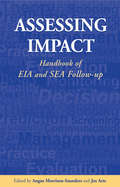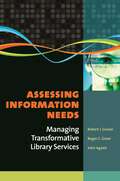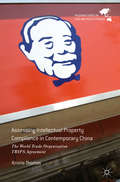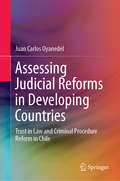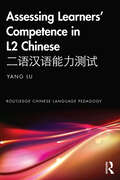- Table View
- List View
Assessing Hate Crime Laws: A Multidisciplinary Perspective (Palgrave Hate Studies)
by Lucille MichelettoThis book offers a critical analysis of hate crime law using Italy as a case study. Employing a multidisciplinary approach, it develops an international framework for mapping hate crime laws onto the phenomenon of hate crime itself, allowing for better legislation to be drafted. It shows how this analytical tool may be used in practice by applying it to legislation in Italy, where Parliament recently dismissed a legislative proposal to extend hate crime law to sex, gender, sexual orientation, gender identity, and disability. The framework allows readers to critique the rationale behind hate crime laws and the effect of, or potential effect of, their implementation. This book ultimately seeks to answer to the question of how and whether States can legitimately introduce a harsher sentence for bias motivated crimes. It bridges interdisciplinary hate studies and more traditional legal analysis. It speaks to an international audience as well as to an audience with a specific interest in the Italian context.
Assessing Headache Triggers: A Practical Guide for Applied Research and Clinical Management
by Dana P. TurnerThis book synthesizes the current research on headache triggers and details how improving the measurement properties of trigger assessments can benefit clinical and research efforts. The book begins with a detailed exploration of the history of triggers and their use in attempts to assign causes to headache attacks. Subsequent chapters then expound on the existing schools of thought on headache triggers with discussions of understudied influences on the causal assignment process, such as the role of individual trigger beliefs and perceptions. After laying this groundwork, the practical application of trigger assessment is thoroughly detailed, including assessment design types and methods of analysis. Chapters then outline the applications of trigger assessment in research and clinical practice. To conclude, the book relays descriptions of future directions and evolving theories in the area.Concise and comprehensive, Assessing Headache Triggers is an invaluable resource for clinicians who treat patients and investigators who aim to improve the lives of individuals with headache through their research.
Assessing Historical Thinking and Understanding: Innovative Designs for New Standards
by Bruce A. VanSledrightAssessing Historical Thinking and Understanding advocates for a fundamental change in how educators think about making sense of learners’ developing cognition and understanding in history. Author Bruce VanSledright argues that traditional and typical standardized testing approaches are seldom up to the task of measuring the more complex understandings students are asked to attain, as they cannot fully assess what the student knows. Rather, he points forward along a path toward changes in learning, teaching, and assessing that closely aligns with the Common Core State Standards. He delves into the types of history knowledge the standards require, illustrates how they can be applied in-use in history learning contexts, and theorizes how the standards might fit together cognitively to produce deep historical understandings among students in teaching-learning contexts. By providing a variety of assessment strategies and items that align with the standards, and identifying rich, useful assessment rubrics applicable to the different types of assessments, he offers an important resource for social studies teachers and curriculum writers alike.
Assessing Historical Thinking and Understanding: Innovative Designs for New Standards
by Bruce A. VanSledrightAssessing Historical Thinking and Understanding advocates for a fundamental change in how educators think about making sense of learners’ developing cognition and understanding in history. Author Bruce VanSledright argues that traditional and typical standardized testing approaches are seldom up to the task of measuring the more complex understandings students are asked to attain, as they cannot fully assess what the student knows. Rather, he points forward along a path toward changes in learning, teaching, and assessing that closely aligns with the Common Core State Standards. He delves into the types of history knowledge the standards require, illustrates how they can be applied in-use in history learning contexts, and theorizes how the standards might fit together cognitively to produce deep historical understandings among students in teaching-learning contexts. By providing a variety of assessment strategies and items that align with the standards, and identifying rich, useful assessment rubrics applicable to the different types of assessments, he offers an important resource for social studies teachers and curriculum writers alike.
Assessing Impact: Handbook of EIA and SEA Follow-up
by Jos Arts Angus Morrison-SaundersWritten and edited by an authoritative team of internationally known experts in environmental impact assessment (EIA), this is the first book to present in a coherent manner the theory and practice of EIA and strategic environmental assessment (SEA) follow-up. Without some form of follow-up, the consequences of impact assessments and the environmental outcomes of development projects will remain unknown. Assessing Impact examines both EIA follow-up and the emerging practice of SEA follow-up, and showcases follow-up procedures in various countries throughout Europe, North America and Australasia. Theoretical and legislative perspectives are examined in the light of detailed case study examples, and the authors present a micro-, macro- and meta scale analysis of EIA practice ranging from individual plan and project level through to the jurisdictional level, as well as an analysis of the concept of EIA. Full coverage is given to the roles of proponents, both private and governmental, EIA regulators and the affected public in designing and executing follow-up programmes. This book is the must-have tool for impact assessment professionals, academics, regulators and proponents working on projects of all scales in all jurisdictions.
Assessing Impact: Handbook of EIA and SEA Follow-up
by Jos Arts Angus Morrison-SaundersWritten and edited by an authoritative team of internationally known experts in environmental impact assessment (EIA), this is the first book to present in a coherent manner the theory and practice of EIA and strategic environmental assessment (SEA) follow-up. Without some form of follow-up, the consequences of impact assessments and the environmental outcomes of development projects will remain unknown. Assessing Impact examines both EIA follow-up and the emerging practice of SEA follow-up, and showcases follow-up procedures in various countries throughout Europe, North America and Australasia. Theoretical and legislative perspectives are examined in the light of detailed case study examples, and the authors present a micro-, macro- and meta scale analysis of EIA practice ranging from individual plan and project level through to the jurisdictional level, as well as an analysis of the concept of EIA. Full coverage is given to the roles of proponents, both private and governmental, EIA regulators and the affected public in designing and executing follow-up programmes. This book is the must-have tool for impact assessment professionals, academics, regulators and proponents working on projects of all scales in all jurisdictions.
Assessing Impairment: From Theory to Practice
by Sam Goldstein Jack NaglieriImpairment and disability are widely used terms, yet considerable disagreement exists as to their relationship—especially when impairment means different things to different professionals in the fields of mental health, medicine, and education. Although diagnostic criteria for various disorders are clearly detailed in the DSM-IV and elsewhere, criteria for impairment remain elusive. And patients with severe limitations but minimal symptoms, or the reverse, further complicate the discussion. The first in-depth treatment of the theory, definition, and evaluation of this core concept, Assessing Impairment: From Theory to Practice cuts through the confusion and cross-talk. Leading scholars and clinicians offer a robust evidence base for a much-needed reconceptualization of impairment within the context of diagnosis and disability, arguing for a wide-ranging quality-of-life perspective. This contextual approach to assessment goes beyond mere symptom counting, resulting in more accurate diagnosis, targeted interventions, and improved patient functioning. Within this concise but comprehensive volume, coverage focuses on key areas including: Current conceptualizations from the DSM-IV and other medical models. Methodologies for measuring symptom severity and impairment. Social/behavioral issues, such as resilience, adaptive behaviors, and family environment. Developmental issues across the life span. Legal and ethical questions and civil rights issues. Impairment and disability as they relate to trauma. The interdisciplinary model proposed in Assessing Impairment gives clinicians vital tools for working with the unique limitations and strengths of every patient. Child, school, and educational psychologists will find it particularly useful, given the critical importance of early detection and the complexity of young people’s lives.
Assessing Impairment: From Theory to Practice
by Sam Goldstein Jack A. NaglieriThis Second Edition of the book expands on the in-depth treatment of the theory, definition, and evaluation of impairment presented in the original volume. It explores the complex relationships between disabling conditions and impairment, with new data and insights on assessment and potential avenues for treatment. Original and revised chapters critique current models of impairment and offers an integrated model rooted in the contexts of medical, mental health, and cognitive challenges in disability. Leading scholars and clinicians provide updated evidence for a much-needed reconceptualization of impairment within the context of diagnosis and disability. This contextual approach to assessment – a wide-ranging quality-of life perspective – goes beyond symptom counting, resulting in more accurate diagnosis, targeted interventions, and improved patient functioning.Topics featured in this book include:The role of family and cross-setting supports in reducing impairment.Relationships between adaptive behavior and impairment.Legal conceptions of impairment and its implications for the assessment of psychiatric disabilities.Impairment in parenting.The Neuropsychological Impairment Scale (NIS).The Barkley Functional Impairment Scale (BFIS).The Rating Scale of Impairment (RSI).Treatment integrity in interventions for children diagnosed with DSM-5 disorders.Assessing Impairment, Second Edition, is a must-have resource for researchers, clinicians, professionals, and graduate students in clinical child, school, and developmental psychology as well as child and adolescent psychiatry, educational psychology, rehabilitation medicine/therapy, social work, and pediatrics.
Assessing Individual Needs: A Practical Approach
by Harry Ayers Alastair Ross Don ClarkeFirst Published in 1996. Routledge is an imprint of Taylor & Francis, an informa company.
Assessing Individual Needs: A Practical Approach
by Harry Ayers Alastair Ross Don ClarkeFirst Published in 1996. Routledge is an imprint of Taylor & Francis, an informa company.
Assessing Information Needs: Managing Transformative Library Services
by Robert J. Emeritus Roger C. Greer John AgadaBased on a tested model for community analysis, this book offers a guide to the management of client-centered transformative information services that can be applied in any type of library or information agency.Knowing a community enables library and information professionals to prioritize the community's information needs and design appropriate services for them. Assessing Information Needs: Managing Transformative Library Services was written to provide the rationale for community analysis, a model for gathering community data, and a process for analyzing data and applying it to the management of an information agency. The book explains why information professionals should customize services, as well as the "how to" of collecting data. A model for gathering community information is described, applied, and demonstrated through a case study. The book then shows how such information is interpreted and used to plan information services that are transformative for individuals and groups in the case-study community, providing lessons that readers can use with their own institutions. Rooted in a philosophy of customer service, the method presented here is perfect for public, school, academic, and special libraries or other types of information agencies.
Assessing Innovation: Metrics, Rubrics, and Standards (Systems Innovation Book Series)
by Adedeji B. Badiru Melinda TourangeauWe cannot manage and control what we cannot measure and assess. Poor assessment results have been cited as a primary reason for project failures, in terms of cost, schedule, and quality. This book introduces metrics, rubrics, and standards pertinent to assessing innovation.Assessing Innovation: Metrics, Rubrics, and Standards provides a new view for the embracing of innovation and establishing a quantitative basis for determining innovation levels. It bridges innovation with practice and presents a systems view as it incorporates the human element and discusses the different roles carried out. This book offers standards that will guide readers as they tackle sustaining innovation and leverages Badiru’s Umbrella Model in the process.The inclusion of methodologies suitable for determining where and when innovation is happening, and to what extent it is currently being carried out, make this a unique book, along with being the only book that addresses innovation metrics, rubrics, and standards in an integrated fashion. Seen as a way to help advance the diverse pursuit of innovation, this book is an ideal read for those in engineering, business, industry, academia, government, and the military.
Assessing Innovation: Metrics, Rubrics, and Standards (Systems Innovation Book Series)
by Adedeji B. Badiru Melinda TourangeauWe cannot manage and control what we cannot measure and assess. Poor assessment results have been cited as a primary reason for project failures, in terms of cost, schedule, and quality. This book introduces metrics, rubrics, and standards pertinent to assessing innovation.Assessing Innovation: Metrics, Rubrics, and Standards provides a new view for the embracing of innovation and establishing a quantitative basis for determining innovation levels. It bridges innovation with practice and presents a systems view as it incorporates the human element and discusses the different roles carried out. This book offers standards that will guide readers as they tackle sustaining innovation and leverages Badiru’s Umbrella Model in the process.The inclusion of methodologies suitable for determining where and when innovation is happening, and to what extent it is currently being carried out, make this a unique book, along with being the only book that addresses innovation metrics, rubrics, and standards in an integrated fashion. Seen as a way to help advance the diverse pursuit of innovation, this book is an ideal read for those in engineering, business, industry, academia, government, and the military.
Assessing Instructional Leadership with the Principal Instructional Management Rating Scale (SpringerBriefs in Education)
by Philip Hallinger Wen-Chung WangThis volume provides a succinct up-to-date summary of global research on principal instructional leadership as it has evolved over the past 50 years. The book’s particular focus is on the development and use of the Principal Instructional Management Rating Scale (PIMRS). The PIMRS is the most widely used survey instrument designed for assessing instructional leadership for research and practice. It has been used in more than 250 studies in more than 30 countries around the world. The authors provide a detailed conceptual and data-based description of the rationale and development of the instrument as well as the ways in which it has been used in practice. The book also provides, for the first time, a comprehensive assessment of the scale’s measurement properties. This represents essential information for future users of the instrument across different national contexts. Finally, the volume outlines an agenda for improving future research on the role of principal instructional leadership in student learning and school effectiveness.
Assessing Intellectual Property Compliance in Contemporary China: The World Trade Organisation TRIPS Agreement (Palgrave Series in Asia and Pacific Studies)
by Kristie ThomasSince its accession to the World Trade Organisation (WTO) in December 2001, China has been committed to full compliance with the Trade-Related Intellectual Property Rights (TRIPS) Agreement. This text considers the development of intellectual property in China, and offers an interdisciplinary analysis of China’s compliance with the TRIPS Agreement using theories originating in international relations and law. It notes that despite significant efforts to amend China’s substantive IP laws to prepare for WTO accession and sweeping changes to domestic legislation, a significant gap existed between the laws on paper and as enforced in practice, and that infringements to the agreement are still prevalent. The book examines how compliance with international rules can be promoted and encouraged in a specific jurisdiction. Making a case for a wider, more interdisciplinary and global outlook, it contends that compliance needs to align with the national interests of relevant countries and jurisdictions, as governments’ economic interests support the greater enforcement of the IP laws.
Assessing Intellectual Property Compliance in Contemporary China: The World Trade Organisation TRIPS Agreement (Palgrave Series in Asia and Pacific Studies)
by Kristie ThomasSince its accession to the World Trade Organisation (WTO) in December 2001, China has been committed to full compliance with the Trade-Related Intellectual Property Rights (TRIPS) Agreement. This text considers the development of intellectual property in China, and offers an interdisciplinary analysis of China’s compliance with the TRIPS Agreement using theories originating in international relations and law. It notes that despite significant efforts to amend China’s substantive IP laws to prepare for WTO accession and sweeping changes to domestic legislation, a significant gap existed between the laws on paper and as enforced in practice, and that infringements to the agreement are still prevalent. The book examines how compliance with international rules can be promoted and encouraged in a specific jurisdiction. Making a case for a wider, more interdisciplinary and global outlook, it contends that compliance needs to align with the national interests of relevant countries and jurisdictions, as governments’ economic interests support the greater enforcement of the IP laws.
Assessing Judicial Reforms in Developing Countries: Trust in Law and Criminal Procedure Reform in Chile
by Juan Carlos OyanedelThis book examines how judicial reform can be effectively assessed through a procedural justice approach. It provides a practical framework for assessment of judicial reform, examining a successful reform in Chile through large scale surveys and longitudinal research.Judicial reform is a key element to democratization and modernization processes in the developing world. Practitioners have struggled with ways to analyze the effects of judicial reform, and to define success. Procedural justice theorists propose that people will obey the law if they consider it fair; this affects willingness to collaborate with the police and the courts, and the general approach that the public has towards social regulations. Judicial reforms such as criminal procedure reforms, which explicitly guarantee the development of a fairer judicial process, represent a scenario that puts these theoretical assumptions to the test. With policy recommendations and applications for international judicial reform, this book tests the real conditions of a procedural justice approach with empirical assessment and analysis. With implications for Latin America and countries undergoing judicial or political reforms worldwide, this book will be an important resource for researchers, policy makers and all those interested in the analysis of judicial reforms, democratization processes and the psychology of justice.
Assessing L2 Digital Multimodal Composing Competence (Routledge Focus on Applied Linguistics)
by Emily Di Zhang Shulin YuThis book focuses on assessing L2 student digital multimodal composing (DMC) competence. It explores key themes, including the conceptualization of L2 student DMC competence, and the development, validation, and utilization of L2 student DMC competence in the tertiary context.Through a thorough review of the DMC literature, the book furnishes readers with a theoretical framework to comprehensively grasp the underlying constructs of L2 student DMC competence. It also provides a delineation of the process of scale development, i.e., defining constructs, constructing items, and analyzing items, scale validation, i.e., the structural, external, and consequential construct validity of the scale, and scale utilization in students’ DMC self- and peer-assessment practices.This practical guidance equips educators and practitioners with the necessary tools and strategies to effectively assess and enhance L2 students’ DMC competence. Scholars and professionals in the fields of L2 writing, language assessment, digital literacy, and technology-enhanced language learning will gain valuable insights from the content.
Assessing L2 Digital Multimodal Composing Competence (Routledge Focus on Applied Linguistics)
by Emily Di Zhang Shulin YuThis book focuses on assessing L2 student digital multimodal composing (DMC) competence. It explores key themes, including the conceptualization of L2 student DMC competence, and the development, validation, and utilization of L2 student DMC competence in the tertiary context.Through a thorough review of the DMC literature, the book furnishes readers with a theoretical framework to comprehensively grasp the underlying constructs of L2 student DMC competence. It also provides a delineation of the process of scale development, i.e., defining constructs, constructing items, and analyzing items, scale validation, i.e., the structural, external, and consequential construct validity of the scale, and scale utilization in students’ DMC self- and peer-assessment practices.This practical guidance equips educators and practitioners with the necessary tools and strategies to effectively assess and enhance L2 students’ DMC competence. Scholars and professionals in the fields of L2 writing, language assessment, digital literacy, and technology-enhanced language learning will gain valuable insights from the content.
Assessing Learners’ Competence in L2 Chinese 二语汉语能力测试 (Routledge Chinese Language Pedagogy)
by Yang LuAssessing Learners’ Competence in L2 Chinese is the first book intended to answer the question on whether existing standardised and classroom-based assessments can reflect learners’ competence in L2 Chinese. The Chinese language has enjoyed increasing global popularity amongst second/foreign language learners and has become one of the major modern languages for school and university curricula. However, to many teachers and researchers, it has been difficult to answer with confidence whether the existing standardised and classroom tests can reflect learners’ competence in L2 Chinese. This book defines and redefines the constructs for assessing L2 Chinese competence that have been overlooked or misplaced because of the unique features of the Chinese language. The book provides theoretical backgrounds and practical methodologies for assessing competence in L2 Chinese trainees and experienced teachers of Chinese as a second language. It will provide invaluable guidelines and ready-made workshop materials for postgraduate teacher training programmes. Researchers and academics will find innovative frameworks on the subject for further studies and debates.
Assessing Learners’ Competence in L2 Chinese 二语汉语能力测试 (Routledge Chinese Language Pedagogy)
by Yang LuAssessing Learners’ Competence in L2 Chinese is the first book intended to answer the question on whether existing standardised and classroom-based assessments can reflect learners’ competence in L2 Chinese. The Chinese language has enjoyed increasing global popularity amongst second/foreign language learners and has become one of the major modern languages for school and university curricula. However, to many teachers and researchers, it has been difficult to answer with confidence whether the existing standardised and classroom tests can reflect learners’ competence in L2 Chinese. This book defines and redefines the constructs for assessing L2 Chinese competence that have been overlooked or misplaced because of the unique features of the Chinese language. The book provides theoretical backgrounds and practical methodologies for assessing competence in L2 Chinese trainees and experienced teachers of Chinese as a second language. It will provide invaluable guidelines and ready-made workshop materials for postgraduate teacher training programmes. Researchers and academics will find innovative frameworks on the subject for further studies and debates.
Assessing Learners in Higher Education (Teaching and Learning in Higher Education)
by Brown, Sally Knight, PeterThis study examines the factors influencing the changes in teaching assessment at the higher education level and studies the range of techniques and methods available to the assessor. It evaluates the effectiveness of certain methods and discusses their implementation.
Assessing Learners in Higher Education (Teaching and Learning in Higher Education)
by Brown, Sally Knight, PeterThis study examines the factors influencing the changes in teaching assessment at the higher education level and studies the range of techniques and methods available to the assessor. It evaluates the effectiveness of certain methods and discusses their implementation.
Assessing Learning in the Lifelong Learning Sector
by Jonathan Tummons Tummons JonathanAssessment theory and practice forms an integral part of the knowledge and understanding required to achieve QTLS. This book is a practical guide and comprehensive introduction to this broad and complex subject area. The text includes chapters on the different types of assessment, feedback, recording, evaluation and inclusive practice and covers e-assessment. Interactive activities are included throughout to help trainees reflect on and develop their own views. This third edition includes coverage of new units of assessment for workplace assessors (TAQA).
Assessing Learning in the Lifelong Learning Sector (PDF)
by Jonathan TummonsAssessment theory and practice forms an integral part of the knowledge and understanding required to achieve QTLS. This book is a practical guide and comprehensive introduction to this broad and complex subject area. The text includes chapters on the different types of assessment, feedback, recording, evaluation and inclusive practice and covers e-assessment. Interactive activities are included throughout to help trainees reflect on and develop their own views. This third edition includes coverage of new units of assessment for workplace assessors (TAQA).



